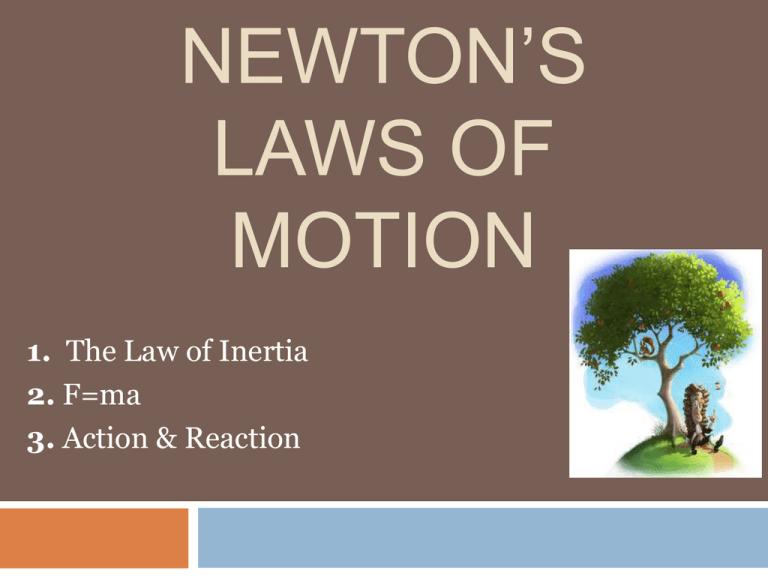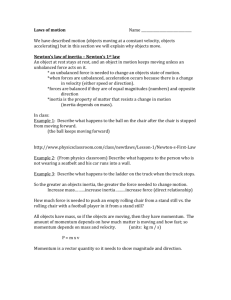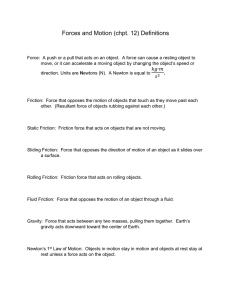Newton's Laws of Motion - Madison County Schools
advertisement

NEWTON’S LAWS OF MOTION 1. The Law of Inertia 2. F=ma 3. Action & Reaction Newton’s Laws of Motion 1st Law – An object at rest will stay at rest, and an object in motion will stay in motion at a constant velocity, unless acted upon by an another force. 2nd Law – Force equals mass times acceleration. 3rd Law – For every action there is an equal and opposite reaction. 1st Law of Motion The Law of Inertia An object at rest will stay at rest, and an object in motion will stay in motion at constant velocity, unless acted upon by an unbalanced force. Inertia is the tendency of an object to resist changes in its velocity. These basketballs will not move unless acted on by a force. 1st Law- Inertia 1st Law Once a force actied on it motion-it would never stop!! ~ unless acted on by a force (push, pull, gravity, air or friction) 1st Law Unless acted upon by an unbalanced force, this golf ball would sit on the tee forever. …BUT… F R I C T I O N Why do we observe every day objects in motion, slowing down and eventually stopping without an outside force acting on them? It’s a force we sometimes cannot see… ALL objects on earth are under the influence of friction. Unlike the frictionless space the moon travels through. Let’s review friction… Friction is… The force that two surfaces exert on each other when they rub against each other. It depends on… 1. How hard the surfaces push 2. The types of surfaces The 4 types of friction: Static Friction Sliding Friction Rolling Friction Fluid Friction Slide your book across your desk gently and watch it come to a stop. WHY? The book comes to a rest because a force was exerted on it friction - which brings the book to a rest. According to Newton’s 1st law, the book would continue in motion at the same speed and direction forever! (Or at least to the end of the desk.) if it wasn’t for that unbalanced force acting on itFRICTION!!! Newtons’s st 1 Law and You Because of inertia, objects (including you) resist changes in their motion. When the car going 80 km/hour is stopped by the brick wall, your body keeps moving at 80 m/hour. Don’t let this be you! Wear seat belts. Mass Matters!!! The greater the mass an object has, the more force it will take to put the object in motion- therefore it will have a greater inertia Newton’s second law says that the amount of acceleration needed to make an object change its motion depends on the MASS of the object and the net force required. SOOO…if you want to find force: Force= mass x acceleration The nd 2 Law 2nd Law Lets try it out! How much force is needed to accelerate a 1400 kilogram car 2 m/s2? Write the formula F= M x A Fill in the formula. (Don’t forget units!!!) F= 1400kg x 2m/s/s Solve the formula. 2800 N Newton’s 2nd Law proves that different masses accelerate to the earth at the same rate, but with different forces. • We know that objects with different masses accelerate to the ground at the same rate. • However, because of the 2nd Law we know that they don’t hit the ground with the same force. F = ma F = ma 98 N = 10 kg x 9.8 m/s/s 9.8 N = 1 kg x 9.8 m/s/s For every action there is an equal and opposite reaction. Newton’s 3rd Law 3rd Law Its BALANCED!! According to Newton, whenever two objects interact with each other, they exert forces on each other. When you sit in your chair, your body exerts a downward force on the chair and the chair exerts an upward force on your body. 3rd Law There are two forces resulting from this interaction - a force on the chair and a force on your body. These two forces are called action and reaction forces. Newton’s 3rd Law in Nature Think about a fish swimming through water. A fish uses its fins to push water backwards. In turn, the water reacts by pushing the fish forward, moving the fish through the water. The size of the force on the water equals the size of the force on the fish; the direction of the force on the water (backwards) is opposite the direction of the force on the fish (forwards). Other examples of Newton’s Third Law The baseball forces the bat to the left (an action); the bat forces the ball to the right (the reaction). 3rd Law Think about your car or bus ride on the way to school. Both are equipped with wheels which spin backwards. As the wheels spin backwards, they grip the road and push the road backwards. Momentum …IT’S THE PRODUCT OF MASS AND VELOCITY The unit is…. Kg × m/s WITH A DIRECTON Momentum = mass × VELOCITY If a small object is traveling at a high speed it can have more momentum that a more massive object traveling at a lower speed. MASS MATTERS!! The Law of Conservation of Momentum In the absence of outside forces, the total momentum of objects that interact DOES NOT CHANGE What outside forces?!? Gravity and FRICTION!!! Movements in Momentum Conserving Momentum The total momentum of any group of object remains the same, or is conserved, unless an outside force acts on the objects. FRICTION!!! Transferring Momentum It is a type of conservation of momentum. Momentum can be transferred from one object to another Collision with 2 moving objects 2m/s 4m/s 4m/s 2m/s Collisions with 1 moving object 0m/s 4m/s When the blue car hits the yellow car, it will transfer its momentum to that car. The yellow car would move at 4m/s and the blue car would be at rest.





